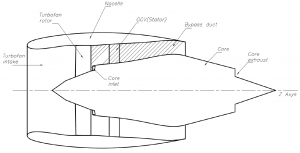
Computational fluid dynamics (CFD) is one of the most important tools in analysis and design of axial turbo machinery as aircraft turbofans or axial compressors. Accordingly, this work presents a review of the state-of-the-art of the main CFD based techniques used for modeling aircraft turbofans. These modeling approaches include the full annulus unsteady Reynolds average Navier Stokes (URANS) simulations, the actuator disc approach, the body force modeling, the frozen rotor model and the mixing planes model. More specifically, comparative analyses of the advantages and limitations of the referred methodologies are initially presented. From the available numerical approaches, the one based on mixing planes is selected for further exploration. The rationale behind the selection of this modeling technique for carrying out turbofan-related simulations in this work is properly highlighted. Finally, numerical simulations of a GE-90 like turbofan engine are carried out using a mixing planes based model. The results obtained from the simulations are discussed in terms of mass, momentum and energy conservation along the turbofan bypass duct. The relative good agreement between the numerical results obtained here and those available in the literature emphasizes the suitability of the modeling approach utilized in this work. Keywords: Aircraft turbofans, computational fluid dynamics, modeling approaches, mixing planes.
Autor(es):AGUILAR, Rene
CELIS, Cesar
LOPES PONTES, Marcio Carmo
Año: 2018
Título de la revista: 17th Brazilian Congress of Thermal Sciences and Engineering
Ciudad: Águas de Lindóia, SP, Brazil
Url: http://10.0.104.54/ABCM.ENCIT2018.CIT18-0300
